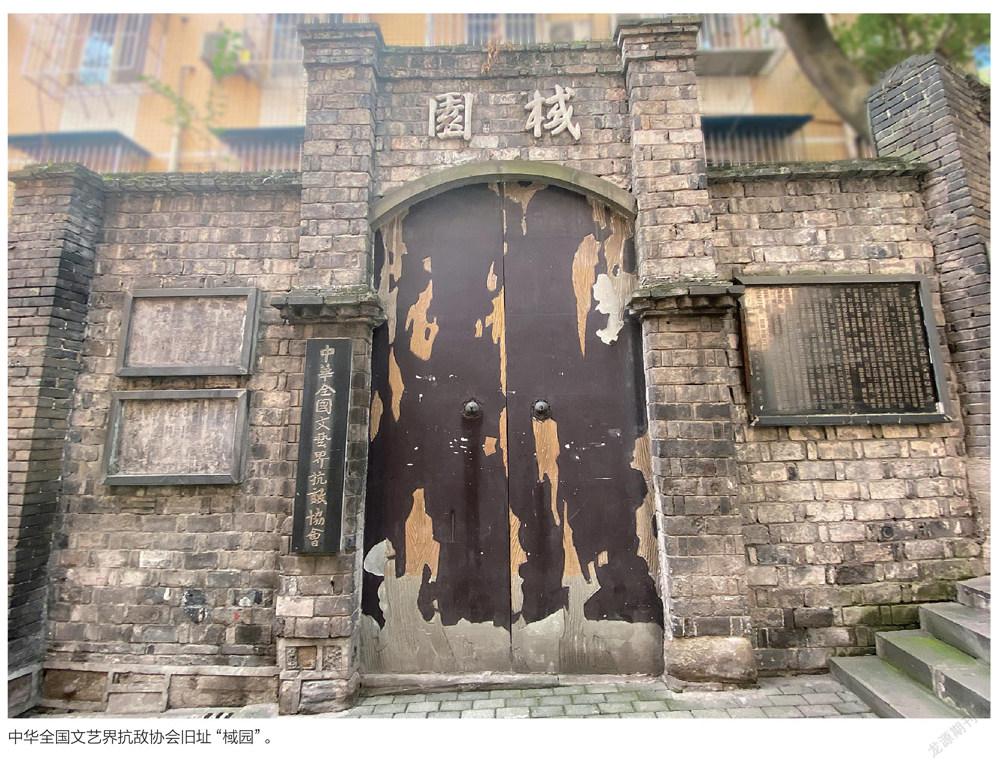棫园,藏在山城步道里的文艺印记
2022-03-23刘丁睿
刘丁睿

Chongqing was called Jiangzhou City and then Chongqing Prefecture about 3,000 years and 800 years ago respectively. Its time-honored history and culture write a book of unique culture and civilization, and Yuyuan (literally Yu Garden), situated in Zhangjia Garden Footpath in Yuzhong District, stands out to be the brightest chapter.
Stepping on the flagging stairs and strolling in tortuous trails, visitors could indulge themselves in the time-honored architectures serving as the carriers of history including Yuyuan, the old gate of Bashu School, former site of Sino-France School, and “Red Army Dormitory”.
Located in No.65 Zhangjia Garden, Yuyuan stands between Zhong Shan No.2 Road and Jialingjiang Binjiang Road. “棫園”, traditional Chinese characters of Yuyuan, are presented against black bricks whose seams are filled with lime powder. It was the old site of the student dormitory of Bashu School, and used to be rent to China Literature and Art Association for the War against Japanese Aggression (Literature and Art Association for short) founded by Zhou Enlai, Sun Fo and Chen Lifu in 1938. Introduction carved on the stone wall says: The Literature and Art Association was established on March 27th, 1938 in Wuhan city, and was then moved to Chongqing in August before Wuhan was conquered. That was the beginning of the fascinating stories of the Association in Chongqing.
To our knowledge, the Association played an important role in forming the united literature and art front to consolidate Chinese people’s faith. Apart from the General Association, it has established branches in Chengdu, Kunming, Guiyang, Guilin, Yan’an, Xi’an, Xinjiang, Xiangfan, Changsha, Qujiang of Guangdong, and Hong Kong.
The Association spent 8 years in Chongqing and held 7 annual meetings where members reported relevant affairs, re-elected directors and discussed guiding issues of literature and art. The well-known slogan of “eradicating three-inch golden lotuses”, which is woman’s bound feet in the feudal age, was advocated in Chongqing for the first time. Meanwhile, the organization also formed Author’s Delegation for Visiting the Battle Field, upheld events to commemorate litterateurs like Lu Xun and Marxim Gorky, and edited and published its journal with wide circulation called Art and Literature for the War against Japanese Aggressions. The uplifting voice they made encouraged numerous young people to devote themselves to save the war-torn Chongqing. Thanks to the contribution of a number of writers, poets, dramatists and historians, culture of Chongqing flourished unprecedentedly. All the stories are hidden behind the brick walls, recording the old days when Chongqing was tiding over adversities.
On Oct. 21st , 1945, after China won the War, the Association was renamed as “China Literary and Art Association”. Its headquarters was relocated to Shanghai. The Yuyuan then became the site of Chongqing branch. In 2004, the government of Yuzhong District built Mountain City Footpath and redesigned the old communities to improve people’s living environment, and renovated and kept the gate and walls of Yuyuan.
Looking at those familiar faces depicted on the moss-spotted rocks while halting outside the Yuyuan, visitors seemed to see the picture of literary figures saving country with their pens: Lao She in a gown, Bing Xin in cheongsam, Mao Dun, Ba Jin, Hu Feng, Zhu Ziqing, Ding Ling, Tian Han, etc.
Currently, a three-meter high and one-meter wide stone gate stays there alone as a witness of the history. Without cheerful voice from arduous hard-working like the old days, Yuyuan now embraces elegant simplicity and grace endowed by time. All bricks and tiles are marked by history. The old buildings are surrounded by green rattan, and cement walls are mottled with moss. Among the lofty White Figs, the narrow alley is winding along, telling the bygone stories to all visitors.
3000年江州城,800年重慶府。城市深厚的历史底蕴,孕育出独特的人文画卷,位于渝中区张家花园山城步道上的棫园,便是其中一幅。
蜿蜒向上的张家花园山城步道,大条石砌成的石梯延伸出各种拐角,棫园、巴蜀中学旧址、中法学校旧址、“红军楼”,这些承载着城市历史的建筑串联,山城记忆就这样不经意地在街巷梯道间展开。
棫园位于张家花园65号,上接中山二路,下接嘉滨路。在青砖为墙、白灰勾缝的院门上方写着两个繁体字:棫园。这里是原巴蜀中学宿舍,1938年租借给由周恩来、孙科、陈立夫成立的中华全国文艺界抗敌协会(简称“文协”)使用。刻在石墙上已经斑驳的文字这样介绍:“中华全国文艺界抗敌协会于1938年3月27日成立于武汉,同年8月武汉失陷前期,迁至重庆。”这就是文协与重庆的开端。
据了解,文协是抗日战争时期中国文艺界最广泛的统一战线组织,起着“统一文艺阵线,巩固精神国防”的作用。文协除总会外,先后成立了成都分会、昆明分会、贵阳分会、桂林分会、延安分会、西安分会、新疆分会、襄樊分会、长沙分会、广东曲江分会、香港分会。
在重庆的8年间,文协举办了7次年会,报告会务、改选理事,研讨带有导向性的文艺问题等,著名的“扫除三寸金莲主义高跟鞋主义”的口号就是在这里提出的。同时,还多次组织作家战地访问团,举办“鲁迅纪念会”“高尔基纪念会”等多种纪念活动,编辑出版大型《抗战文艺》会刊。在这里,一次次激扬的呐喊,感召了无数青年人投入革命战时的重庆。正因为有着无数的作家、诗人、戏剧家、史学家的加入,才使得重庆的人文氛围空前,而这些璀璨的历史,全都掩藏在这小小的砖墙背后,掩藏在那些看似不堪风雨的日子里。
抗日战争胜利后,1945年10月21日,中华全国文艺界抗敌协会更名为“中华全国文艺界协会”,同期会址改设上海。重庆成立分会,棫园便成为分会会址。2004年渝中区政府修建山城步道,打造特色老社区改善居民居住环境,修缮并仅保存了棫园的院门及墙体。
驻足在棫园的墙外,看着斑驳苔痕石画上那些熟悉的面孔,眼前不由得出现身着长衫的老舍、穿旗袍的冰心,以及茅盾、巴金、胡风、朱自清、丁玲、田汉等精英大家“文艺救国”的画面……
如今这里,仅剩下一扇高约3米、宽约1米的小石门,作为那段历史的见证。虽少了激扬和奋斗的声音,却多了时间沉淀下来的古朴与柔美,每一砖一瓦都被刻上岁月的烙印。老房子已爬满青藤,泥水墙已经斑驳,黄葛树也已参天在低矮的砖木房子中间,唯有眼前窄窄的小巷还在一直蜿蜒向前……
